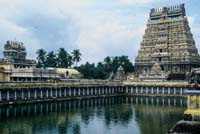 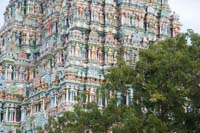    
  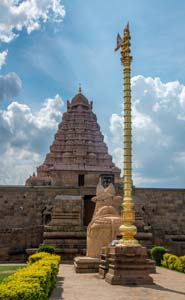  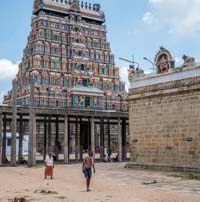  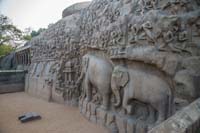  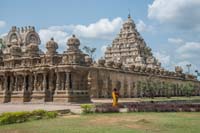 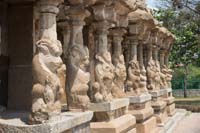 |
Temples of Tamil Nadu 12 days from Chennai Day 1 Sightseeing in Chennai Once known as Ft. St George, this is where the British East India trading Company got its start and it is still the commercial capital of Tamil Nadu. There’s plenty of Raj era sights to see from Fort George to the Railway station, but the highlight is bound to be the collection of 700 Chola Bronzes in the Pantheon Museum. In the evening, head out with the locals for a walk along the 8 mile stretch of the Marina. You would think with all this history, there would be choices of heritage hotels, but the only one is the Vivanta by Taj Connemara. www.vivantabytaj.com It was once residence of the British governor and is decidedly swank with a pool and tropical gardens. Day 2 Day excursion from Chennai to Kanchipuram and return to Chennai (Or possibly to Mahabalipuram) Kanchipuram, one of India’s seven sacred cities, is about a 1 1/2 hour drive west of Chennai. Besides being a major silk producing center, it is home to about 70 temples from the 4th C. Pallava Dynasty. There are 2 temples here that are very important. The Ekambaresvara Temple is famous for its Thousand Pillared Hall. It was built by the Pallavas and enhanced by the Cholas. The inner sanctum is open only to Hindus, but the carvings and the sacred mango tree are all worth seeing. The Kailasanatha Temple is the oldest temple in Kanchipuram, dating back to the Dravidian era and has good examples of carvings from that era. Day 3 Drive from Chennai to Pondicherry Depart Chennai (a.k.a. Madras) in the morning. It’s only a 46km drive south to Mahabalipuram (a.k.a. Mamallapuram), During the 7th century this was the Pallava dynasty’s seaport which launched Hinduism to the far corners of Southeast Asia. It’s easy to see the artistic similarities between the magnificent shore temples here and the temples in Vietnam and Indonesia. The Panch Ratha (“Five Chariots”) temples are eroded by wind and sea, but are still evocative and usually full of Hindu pilgrims. The 2006 tsunami even managed to uncover a couple of new little gems. Nearby is one of India’s most famous bas-relief carvings, Descent of the Ganges – also known as Arjuna’s Penance. There are some other nice caves to explore, then perhaps have lunch and set off south for the 3 hour drive south to Puducherry (a.k.a. Pondicherry) There’s not lot of “monument” type sightseeing here, but it’s a wonderful place to hang out. It was a French protectorate until 1954, still drips with old world charm. Walk along the beach and the French Quarter, or visit the Ganesh Temple (Sri Manakula Vinaayagar) If you want to visit the Sri Aurobindo Ashram, be sure to make arrangements in advance by going to their website. www.sriaurobindoashram.org They are set up for stays of a week or more, if there is space, they will allow you to stay for one night. Hotels: The most important thing in Pondecherry is to stay in the old French part of town. It’s green and pleasant with lots of cafes and cute craft shops. There is a wealth of charming heritage hotels. Talk to your tour operator, but the ones I know I liked in 2017 are: Les Hibiscus, but with only 4 rooms, it will be tough. www.leshibiscus.in, Hotel de l’Orient www.neemranahotels.com Le Dupliex www.leduliex.com L’Escale ( it has ocean views) www.lesalepondicherry.com and the Hotel Pondicherry which doesn’t seem to have a website but can be called at 91 0413 222-7409 Day 4 Drive to Kumbakonam via Chidabaram You’ll want to leave Pudacherry early for the 2 hour drive to the ancient Chola Dynasty capitol of Chidabaram, The piece de resistance here is the 6th century, gold plated roofed Shiva Nataraja Temple, but it closes from noon to 4:30PM. It’s a huge complex and will take a couple of hours to see it. Also, be forewarned – cameras are not allowed in the inner most courtyard. Vedic priests, descendants of the original caretakers from 3000 years ago, will show you around the five massive halls. Shiva performed his cosmic dance on site and the bronze Shiva Nataraja statue commemorating this is one of the highlights of Indian art. After lunch, continue west for another 2 ½ hours to the small town of Kumbakonam. There are 18 temples in this town, but consider seeing the Kumbesvara which is the largest one, and Nagesvara Swami which has a carved stone chariot drawn by horses. There is also a nice Vishnu temple here – Sarangapani which is full of cows. Hotel: Indeco Swamimalai. This is one of my all-time favorite heritage hotels. The owner bought an entire abandoned village and painstakingly restored it. The main building (with 4 rooms, which you might want to request) is a merchant’s home which was brought in from Chennai. The entire property is part museum, part hotel and he has taken great pains to employ the local townspeople. The only downside is that there is a new annex for groups so that the dinner and breakfast buffet were a bit chaotic. My feeling, however, was that the good far outweighed this minor inconvenience. Day 5 Drive via Swamimalai and Gangaikondacholapuram to Thanjavur (a.k.a. Tanjore) All totaled, the distance from Kumbakoman to Thanjavur is 65km, mostly along the beautiful Coromandal coast, but there are a couple of interesting stops along the way. Swamimali is home to the remaining bronze casting artisans who once made the famous Chola bronzes, renowned worldwide for their fine detail and exquisite workmanship. A little further on, is the huge granite temple of Gangaikonda Cholisvaram. Built in 1020AD, it is over 60 meters high and contains the largest Shiva lingams in South India. When you get to Thanvajur, remember that there’s an extra day here, so you might want relax and walk around the town a bit. Probably the best bet for a hotel here is the Ideal River View Resort – a collection of cottages with a pool and potential yoga lessons. http://www.idealresort.com Day 6 Sightseeing in Thanjavur Thanjavur was the capital of the Chola Dynasty at its apogee. This was the most powerful South Indian kingdom and is responsible for spreading Hinduism and Indian culture into Asia. The Brihadisvara Temple – now a World Heritage Site – was built in 1000 AD and is one of the marvels of Hindu architecture. The main gopurum is over 70 meters and is covered with sculptures. The black granite Nandi Mandapa is one of the largest in India. Don’t leave without finding the brightly painted elephant who will take your donation out of your hand with his trunk. In the afternoon, visit the Royal Palace. Built by the Marathas in the 16th century, this palace has several worthwhile things to see inside. The Observation Tower and the Durbar Hall are beautiful. The Art Gallery contains Chola bronzes and paintings. The Tanjore painting style is one of the most famous schools of painting in India and is very unique, with bright colors and nicely rounded human figures. Day 7 Drive to Trichy (a.k.a. Tiruchirappalli) via Srirangam It should be only about a 2 hour drive to Srirangam, situated just north of Trichy. This is, perhaps, India’s largest temple complex, set on an island at the confluence of the Kaveri and Kolidam rivers, The Ranganathasvami Temple, dedicated to Vishnu, is one of the largest in India. The 21 carved and painted gopurumas and Thousand Pillared Hall (Ok, only 540, but who’s counting?) are magnificent. On the banks of the river, worshipers come to worship, bathe, cremate the dead. Even though non-Hindus are not allowed into the inner most sanctuary, there is plenty to see. After lunch, it’s only 5 miles down to Trichy. The town of Trichy itself, is pretty quiet. There is a rock fortress 270 up on a hill, if you fancy a climb. If not, there are 2 cave temples at the base of the hill. There are no particularly interesting hotels here, but you might want to try the Breeze Residency www.breezeresidency.com It is simple but very comfortable. Day 8 Drive to Chettinad In the post WWl era, the merchants and bankers in this area became fabulously wealthy and built thousands of magnificent mansions. No expense was spared as massive amounts of teak, marble, and rosewood were put into the homes with countless inner pavilions. The best known is the Lakshmi House, famous for its carved wood ceilings. There are several small temples in town as well as many antique stores that sell the cast-offs from the mansions. The local cuisine here is famous – curries are served up on banana leaves. If you can, spend the night here because the hotels are some of the finest examples of this historic architecture. The Visalam www.cghearth.com and The Bangla www.thebangle.com are the 2 most famous. Day 9 Drive to Rameswaram. The drive today could be as long as 4 hours as the road is quite rural. Check with your tour operator for the latest. According to the Ramayana, The Rameswaran Temple is where Rama and Hanuman led their army into Sri Lanka to rescue Sita. Shiva stopped here after that battle to leave a lingam, which is the central relic in this temple. There are 5 gopuras **, but the highlight is the corridor around the inner temple. It is made up of 1212 pillars, carved to resemble bulls holding up the beautiful painted ceiling. It is a pilgrimage site for both Hindus and Sikhs (Govind Singh came here) so it is always full of people and raucous happenings. The fishing villages that surround it are interesting and the shore areas are charming. If you have plenty of time, you might want to go to the eastern most tip of the island, about 20 km from the temple. The village was pretty much destroyed in a 1964 cyclone, but a small temple still stands and you will be able to see the Adam’s Bridge boulders that Hanuman used to get to Sri Lanka. Hotels here are pretty standard, but you might try the Sri Saravana. www.srisaravanahotel.com Day 10 Drive to Madurai It will be about a 4 hour drive to get back to Madurai, so you might want to spend the morning re-visiting the Rameswaran Temple. Drive back to Madurai where, even from outside town, you will see the 9 huge gopurums if the Meenaksi Temple. While the temple in Tanjore is the most important historically, this one is probably the mother-lode of South India temples. You will have the day tomorrow to go through the temple, so perhaps today you could get involved with all the colorful chaos that surrounds it. Thousands of Hindu pilgrims will be there. Street sellers hawk flowers, food, and religious items. The Gandhi Museum is housed in a 300 year old palace that is reason enough to visit it. . Return to the temple area by by 6PM for performances of live bhajan music. As the sun sets, a great procession – occasionally led by an elephant – brings a statue of Sundareshvara back into the temple to spend the night with Meenakshi. There are plenty of very nice hotels here such as The Heritage Madurai www.heritagemadurai or the Park Plaza, but if you are looking for something special, try the Madurai Gateway. www.thegatewayhotels.com It is perched on top a hill just out of town with spectacular views over the temple. Ask for rooms in the colonial mansion. Day 11 In Madurai Dress very conservatively this morning (no shoulders or legs showing) and set off for the temple. Years ago, cameras were allowed with a fee, but the 2015 edition of Lonely Planet says that now only mobile phone cameras are allowed. Check on this out before you go and decide what to do. This enormous temple is dedicated to Shiva (known here as Sundareshvara – the handsome God) and Meenakshi (The Fish Eyed Goddess, as Parvati is called) the 4 main gopurums and 8 lesser gopurums are covered with thousands of stucco figures. The whole thing is painted once every 12 years (last time in 2009) so it fades from brightly colored to more subtle. It will take you the better part of the day to see this huge complex. It covers 15 acres with tanks, pillared hallways, pavilions, and shrines and thousands of pilgrims. Day 12 Take the train back to Chennai It’s about a 6 hour train ride from Madurai back to Chennai. |
